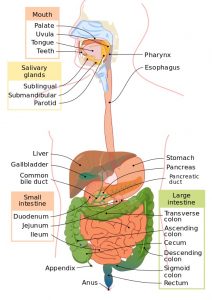The digestive tract is responsible for the processing of the foods that you eat, from the time you put food in your mouth, until you eliminate the material from your body. With all of these parts that have to work together, from the stomach to the gall bladder to the large intestine, it’s amazing how everything can go right. It’s a highly organized system that provides you with nutrition and water, which in turn supports life.
The below image is a diagram of the human digestive system.
Top 20 Fun Facts
- Contrary to popular belief, the stomach isn’t the main source of food digestion. While mechanical digestion occurs in the stomach, most of the work is done by the small intestine.
- It doesn’t take gravity to move food down your esophagus. The muscles of the esophagus move food down to the stomach. This means you can eat upside, but beware of choking.
- The stomach has to protect itself from acid erosion by lining itself with a layer of mucus. This keeps the hydrochloric acid that is in the stomach digesting food from breaking down the stomach as well.
- The stomach produces a new layer of mucus every two weeks to protect itself, while it produces half a gallon of hydrochloric acid each day.
- The digestive system uses enzymes to break down foodstuffs. Proteases break down proteins, while amylases target carbohydrates. Lipases act on fats to break them down.
- Some laundry detergents use the same enzymes that your body uses to break down food in order to break down stains.
- The small intestine isn’t small at all. Stretched out, it would cover space the size of a tennis court. This is due to the folds in its walls, known as villi and microvilli that provide increased surface area.
- Stomachs vary widely between species. Ruminants such as cows have a four-chambered stomach, while seahorses and platypuses don’t have a stomach at all.
- When you pass gas, it’s related to the fermentation occurring in the large intestine. Bacteria work on digesting the remaining food material that makes it to the large intestine. As they work, they release gases, such as methane and hydrogen sulfide.
- The digestive system is linked to cancer in more people and causes more mortalities than any other body system.
- To look inside the stomach for the first time in a living person, doctor Adolph Kussmaul used a primitive endoscope. He had to use a sword swallower to swallow the tool as it was rigid but provided the first look at the stomach.
- The role of hydrochloric acid on digestion within the stomach was determined by a physician working with a man who had a fistula, a hole in his stomach wall allowing access from outside of the body. Food could be placed directly in the stomach through the fistula.
- Borborygmi describes the sounds your stomach makes when it rumbles. It can happen when you’re hungry or even when you’re not hungry. They sound loudest when your stomach is empty, as peristaltic waves move through your intestines.
- A normal or average person produces enough saliva to fill two soda cans every day, roughly 2 pints.
- Your stomach can stretch to hold up to four pounds of food at one time.
- When you throw up, your body produces more saliva to protect your teeth from gastric acids.
- Burps are designed to release excess air that the body intakes from drinking carbonated beverages, smoking, or eating too fast.
- It can take a food bolus 2 to 5 seconds to travel down the esophagus to the stomach.
- Other organs are accessories to the digestive system. The liver and pancreas produce materials to aid in digestion, including bile and proteases.
- Dietary fiber is very important. It softens the stool and bulks it up. In addition, it can affect the health of the gut bacteria.

